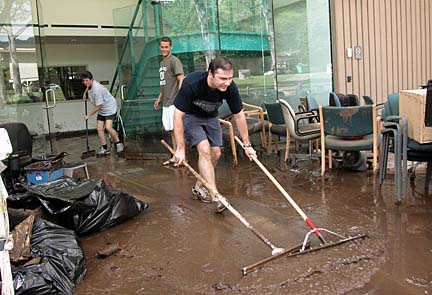

|
Flood loans
available
Oahu's declaration as a disaster
area will help area residents
Oahu was declared a disaster area yesterday, a move that will allow residents and businesses affected by the Oct. 30 floods to apply for federal loans.
Offices open to handle
|
More than 190 homes and businesses, an elementary school and several University of Hawaii-Manoa campus buildings were damaged by the Halloween eve flood, caused by more than 10 inches of rain that fell in the upper Manoa Valley over 12 hours.
The disaster declaration will allow nonprofit organizations and businesses of any size to borrow up to $1.5 million. Small businesses will be eligible for economic injury disaster loans of up to $1.5 million. The SBA also expects to offer other loans to help victims with improvement costs to prevent damage from future floods.
Meanwhile, some geologists at the University of Hawaii are investigating what contributed to the flood. And so far, urbanization seems to be a strong factor.
"In situations where you have urbanization, increased runoff is a typical byproduct of that," said Patricia Cooper, associate dean of the School of Ocean and Earth Science and Technology. "Once the ground is paved over, there's no place for the water to go. It doesn't sink in at all."
She added, "When you have done nothing to accommodate the increased runoff, you can expect flooding problems."
Cooper said studies on area bridges and flood control were done 50 to 75 years ago, when there were not as many homes and businesses in places like Manoa Valley.
Because of the flood, UH geologists and the Army Corps of Engineers are considering whether to add Manoa Valley to a $1.5 million federal flood-control plan for the Ala Wai Canal and Waikiki.
Manoa Stream started flooding deep in the valley, and water "flowed downhill in pretty much a straight line," Cooper said, affecting the Manoa Marketplace, Manoa Innovation Center, Noelani Elementary School and the University of Hawaii.
Bridges clogged with debris such as logs and vegetation at Woodlawn Drive and East Manoa Road didn't help, but they weren't the cause of the flood, she added.
Eric Hirano, a chief engineer with the Department of Land and Natural Resources, said his office recently met with other state, city and federal officials to discuss possible short-term measures.
"These measures are not to eliminate flooding at the Manoa Stream but to reduce the magnitude," Hirano said.
He said a lot of debris was pushed against chain-link fences by the flooding waters. With nowhere to go, the debris channeled rushing waters to "places where we didn't want the water to go," Hirano said.
Installing breakaway fences is one suggestion under consideration. The state also is considering expanding the drainage ditch at the Manoa Valley District Park, raising the elevation of Woodlawn Drive so rainwater flows back into Manoa Stream, and doing other engineering work to channel rainwater into the stream more effectively.
Officials are expected to meet again sometime in December to further discuss short-term solutions.
Waialua to get
flood warning
system in 2005
State and federal officials are working together to improve the flood warning system for residents in Waialua.
During this past legislative session, the state Legislature approved $75,000 in matching funds to install a flood warning system for residents living around Lake Wilson -- primarily those living in Otake Camp and Waialua.
Flooding is "a recurring problem," said Kevin Kodama, hydrologist at the National Weather Service who is working with federal officials to implement the warning system. "If there was some type of system, you can give them advance notice."
The state Civil Defense Division, U.S. Geological Survey, Department of Land and Natural Resources and the National Weather Service are collaborating.
The system will include four gauges to measure the water level of the rain, stream and lake. Officials want it installed by September 2005, said Barry Hall, district director of the U.S. Geological Survey.